How the Punic Wars Changed the Course of History
The Punic Wars led to Rome's rise as the dominant power in the Mediterranean, fundamentally shaping Western civilization.
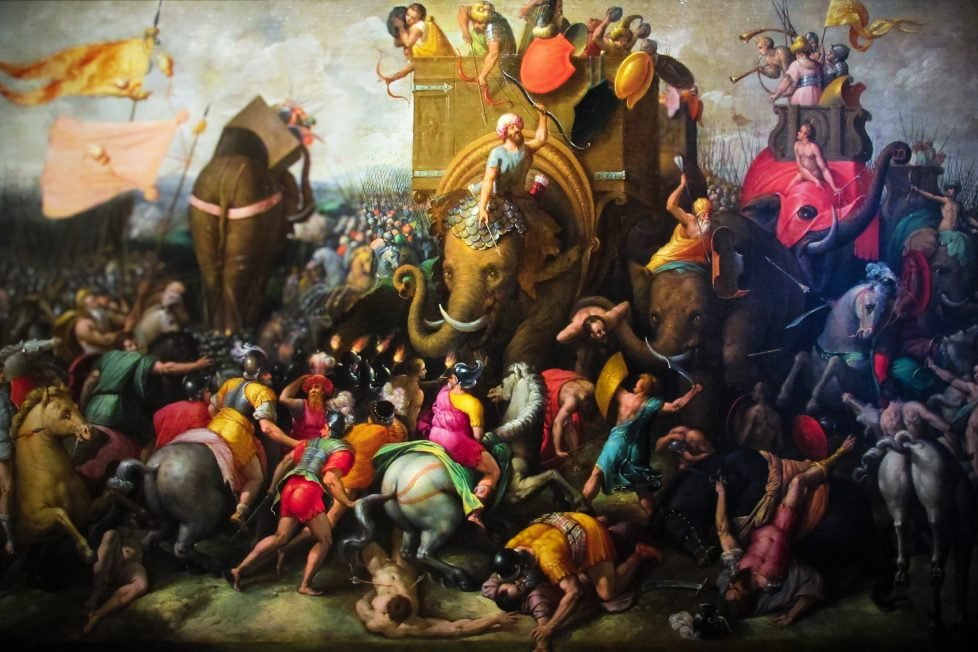
The Punic Wars led to Rome's rise as the dominant power in the Mediterranean, fundamentally shaping Western civilization.

Table of Contents
ToggleBy their very nature, wars change the geography, history, geopolitical power of balance and destinies of whole nations. Human history is nothing more than a long series of wars and peace that follow each other like day and night, although each phase in this recurring sequence of wars and peace may last decades or centuries.
Some wars are so consequential that they’ve changed humanity’s destiny and force historians, academicians, and laypeople to ponder how different the world would have been if the losing side had won a particular war or battle.
This feeling has inspired a whole field of alternate history that many of our readers may be aware of. The Punic Wars were among the few such wars that changed the destiny and the lives of perhaps billions of people, and their effects can still be felt in areas far away from the epicenter of these wars.
Ancient Carthage started out as a Phoenician colony in the 9th century BC when Phoenicians were setting up trade posts and colonies for their maritime empire that was primarily interested in trade across the whole Mediterranean region. Ancient Carthage survived the downfall of Phoenician civilization and emerged as the seat of the powerful Carthaginian Empire that ruled vast swaths of land in North Africa and Europe.
Few people realize that at the time of the outbreak of the Punic Wars, the Carthaginian Empire was superior to the Romans in every possible way imaginable. At the time of the first conflict between the Roman Republic and the Carthaginian Empire, Romans had just united the Italian Peninsula, while Carthaginians had been ruling Southern Spain, Libya, Tunisia, Algeria, Morocco, and most of Sicily for centuries.
Ancient Rome, at the time of the outbreak of the First Punic War, was an emerging power that had just recently managed to unify the Italian Peninsula and was eager to get a hold on Sicily, which was under the control of Carthage. Before the outbreak of hostilities, Carthage and Rome had friendly relations. No one would have expected that the cordial relationship would deteriorate to such an extent that it’d lead to a series of long and exhausting wars lasting for more than a century.
Ancient Rome and Ancient Carthage were founded around the same time and had similar governments, with a senate controlling all the state affairs. However, they also differed significantly from each other as Carthage was a trading empire that relied on its superior navy, while Rome was essentially a land-based power that excelled in land warfare.
Although the wars would force both the powers to improvise rapidly, leading to Rome acquiring a strong navy and Carthage would also prove to be a formidable foe to beat on land thanks to legendary generals such as Hannibal Barca.
At the start of this epic conflict between Rome and Carthage, both sides had cordial relations, and there was almost no possibility of war. The Roman Republic had just recently managed to unify most of the Italian peninsula, while Carthage and the Greek city-state of Syracuse controlled the island of Sicily. Carthage also controlled the islands of Sardinia and Corsica.
As the name suggests, the First Punic War (264-241 BC) was the first of the three Punic wars. The First Punic War was mostly fought on the soil of Sicily, and it started with the Roman attack on Messana (today known as Messina), a city under Carthaginian control at that time that was located on the Strait of Messina.
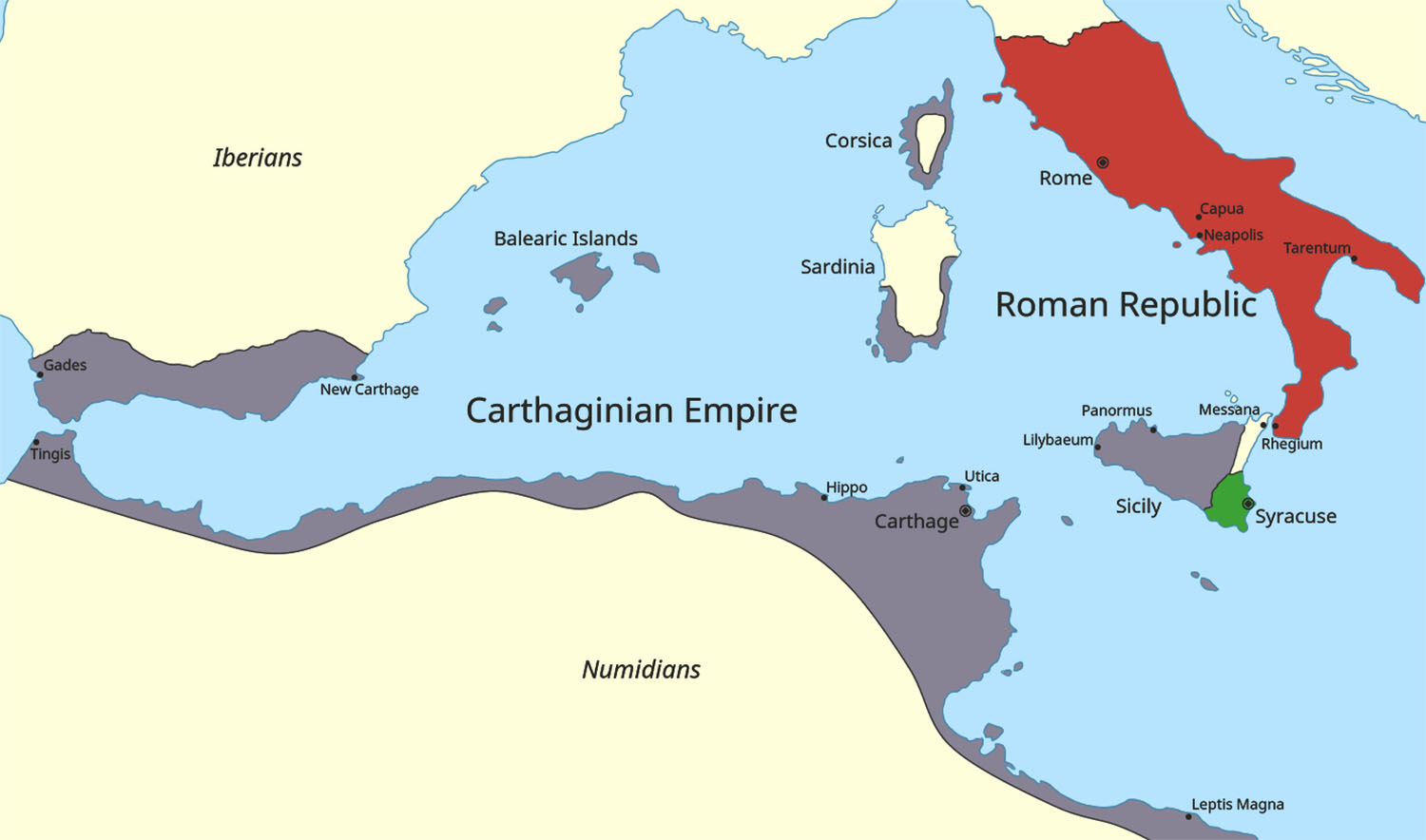
Romans were under no illusion as they knew an attack on Messana would spark an all-out war with Carthage. The Roman Senate hotly debated sending an invasion force to Messana. Then, the popular assembly, as the Roman Senate had entered a deadlock over the idea of attacking Messana, voted in favor of the invasion.
Carthage had a presence in Sicily for more than 2 centuries, while Romans had no presence on the island of Sicily. This was all going to change now. The Carthaginians were a marine empire that was known for having perhaps the best navy in the ancient world, and the Romans would also construct a formidable navy during the course of the war.
The Battle of Messana was the opening battle of the First Punic War in 264 BC. A Roman force of 9,000 soldiers defeated a numerically superior Carthaginian and Syracusan force of 12,000. This battle led to the Romans capturing Messana and marked the start of the first Punic War, which would last for 23 years.
Roman success in the battle of Messana would set the tone for most later engagements, and it was soon followed by an even greater triumph after the Battle of Agrigentum. This was the first major pitched battle between Rome and Carthage that was fought on Sicilian soil during the first Punic War.
Rome eventually won this battle, although it was a pyrrhic victory due to the enormous losses suffered by Rome. Syracuse also switched sides at around 263 BC after a lengthy Roman siege as Carthage failed to provide any aid to Syracusans, and they were left with no option other than to join Rome.
This provided the Romans with a vital ally in their war effort. The alliance with Syracuse would also prove a boon to the Roman war effort as Syracuse agreed to help recruit soldiers in Sicily.
The First Punic War was a series of skirmishes, raids, and guerilla warfare on land, as just 4 pitched battles fought on the Sicilian soil between Rome and Carthage. In contrast, the Naval theater of the war saw some real action with several naval engagements between Rome and Carthage.
Most of the Carthaginian towns in Sicily were coastal cities and were well fortified. This made it easy to supply them via sea, and the garrisons within these towns could successfully resist any Roman attack. Rome didn’t have a navy at this time, but the Roman military leaders realized that the only way to capture these towns was by building a strong navy.
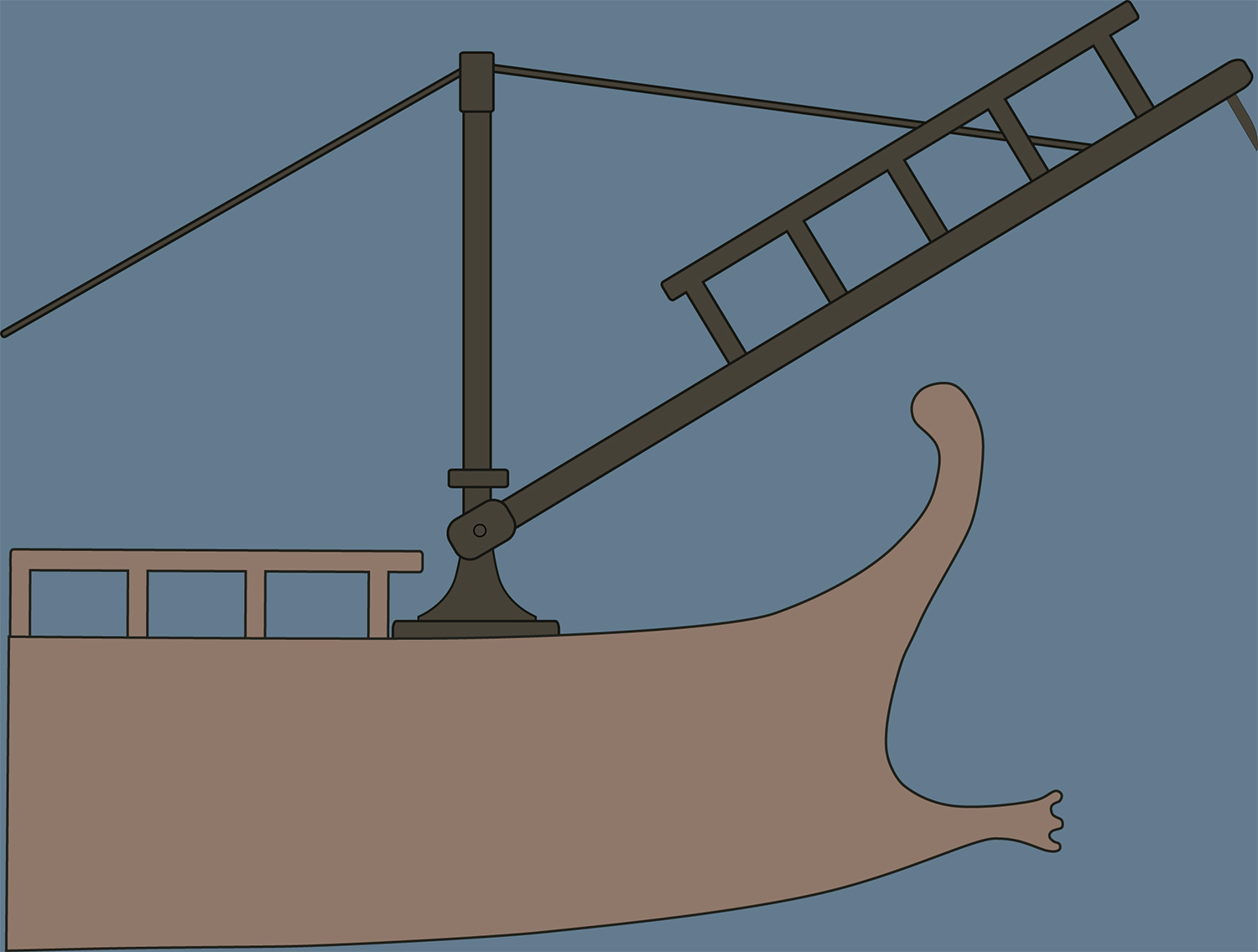
Romans captured a Carthaginian ship and copied its design to build a navy from scratch. Romans were able to build a fleet of 120 ships in a short amount of time, and this fleet came in handy during the Battle of Mylae in 260 BC. This battle marked a watershed moment, as the Roman navy not only won against the superior and more experienced Carthaginian fleet, but it also was the first time Romans used Corvus, a type of bridge that allowed Roman sailors to onboard enemy vessels and effectively turned the naval battle into a version of land warfare in which Romans excelled.
Soon, more victories, such as the Battle of Sulci in Sardinia, would shift the balance of power in favor of Rome.
Romans also launched an unsuccessful invasion of Carthage in 256 BC once they were tired of the stalemate on land in Sicily. The Roman invasion fleet would face the Carthaginian fleet at the Battle of Cape Ecnomus. This would be the largest battle of the whole war and perhaps the largest naval battle of antiquity, as the Roman fleet of 350 ships and 150,000 marines and sailors would face the Carthaginian fleet of 330 ships and 140,000 marines and sailors.
Romans emerged victorious in this naval battle, but the invasion of Carthage would ultimately fail thanks to the Carthaginian victory at the Battle of the Bagradas River in 255 BC. Once the Romans realized that storming Carthage was not an option, they focused their attention back on Sicily, where Carthage was down to just 2 cities of, Lilybaeum and Drepana, by 248 BC.
Both sides were exhausted at this time as the war had lasted for almost 16 years, and Carthage and Rome were running out of money and manpower to sustain the war further. Hamilcar Barca, the father of famed Carthaginian general Hannibal Barca, was the last commander of Carthaginian forces in Sicily, and he would go on to conduct a guerilla war against Romans from the two cities still under Carthaginian control.
This low-intensity conflict lasted until 243 BC when Rome realized they’d need to build a new fleet to effectively blockade these two cities under Carthaginian control. Rome managed to build a new fleet of 200 warships with donations from wealthy citizens of Rome.
Carthage also built a new fleet to face this new Roman fleet of 200 ships. Both fleets would meet in the Battle of the Aegates Islands, which the Romans won. The Carthaginian Senate now instructed Hamilcar Barca to negotiate for peace, and the ensuing negotiations resulted in the Treaty of Lutatius.
This treaty imposed hefty war reparations on Carthage, and their centuries-old presence in Sicily would end. As a result of this war, Rome gained Sicily, Sardinia, and Corsica. The First Punic War also made Rome the dominant power in the Western Mediterranean Region and shifted the balance of power in favor of Rome.
Carthage had ceded Sicily, Sardinia, and Corsica to Rome after losing the First Punic War, and this was a severe blow to the prestige of Carthage as now, they were no longer the dominant power in the western Mediterranean. As expected, this defeat led to a clamor for vengeance against Rome, leading to the Second Punic War just 23 years after the First Punic War.
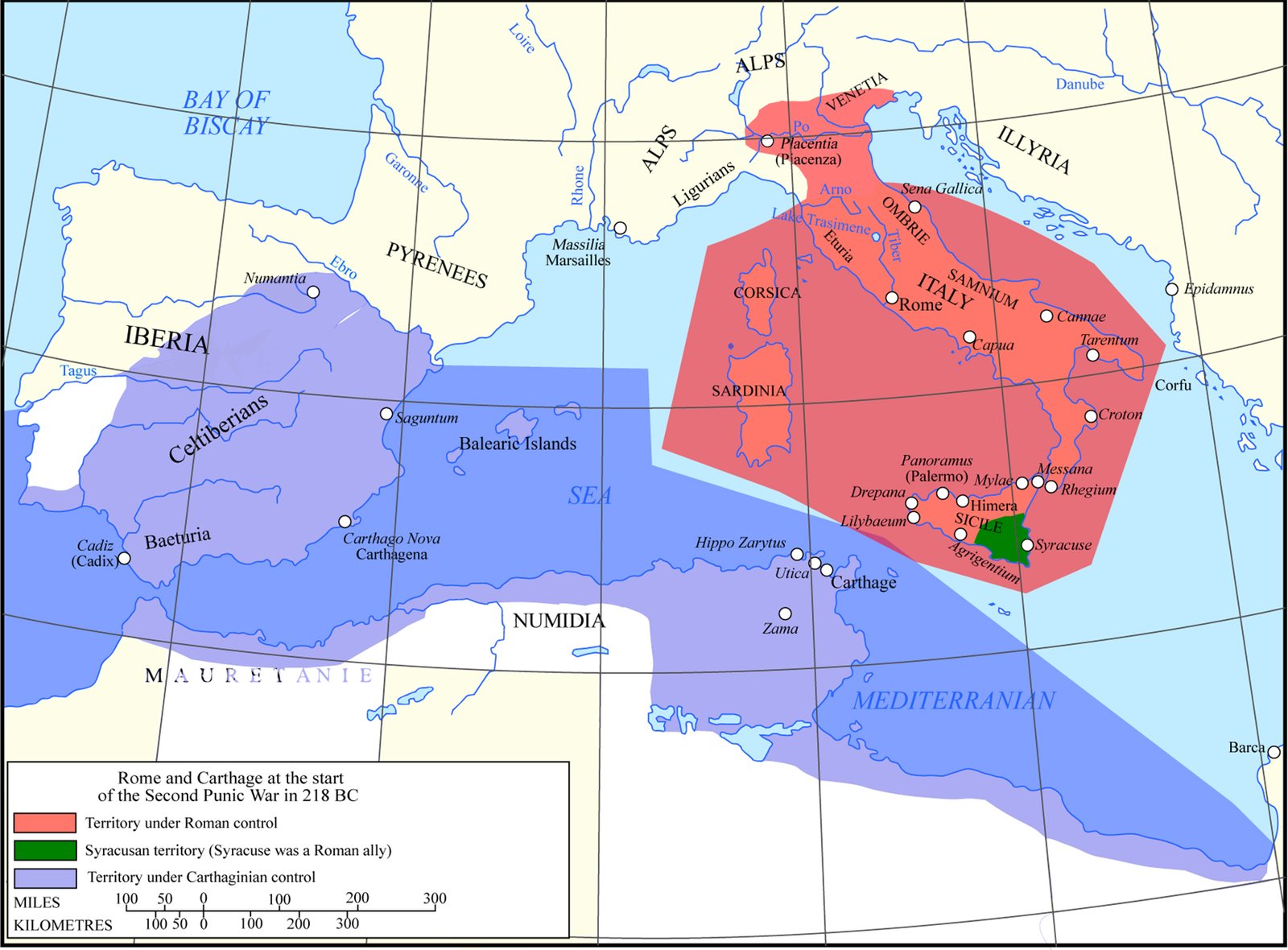
Unlike the First Punic War, the Second Punic War would be primarily land-based. Carthage would achieve some spectacular victories against Rome thanks to the legendary General Hannibal Barca.
Hannibal famously crossed the Alps to invade Italy, a task that no other military leader before or after him would accomplish. Before the start of the Second Punic War, Carthage had acquired Southern and western Iberian territory that today corresponds to Southern Spain and Southwestern Spain.
Hannibal set out from Spain with a formidable army of 40,000 infantry and 12,000 cavalry, and this was also the first time that African Elephants would be used in land warfare in Europe.

After the treacherous journey through the Alps, where Hannibal managed to outmaneuver several hostile tribes, Hannibal’s army would cross into the Roman region of Cisalpine Gaul, corresponding to today’s Northern Italy, sometime around November 218 BC.
The journey was so difficult that Hannibal’s army was reduced to 20,000 infantry and 6,000 cavalry, or almost half of their initial strength, when they left Iberia. The next several years were filled with wars that were simply disasters for Romans, as within 2 years of his arrival in Italy, Hannibal would go on to kill 200,000 Roman soldiers in various battles.
The first major battle of the Second Punic War was the Battle of Trebia, which took place on 22 or 23 December, 218 BC in which a 40,000-strong Roman Army fought with an equally matched army led by Hannibal that included the original Carthaginian army and also had significant troops from nearby Gallic tribes.
This battle was a complete defeat for the Romans as the Roman Army had more than 20,000 of its soldiers killed in the ensuing battle. These two battles would be followed by the Battle of Lake Trasimene in June 217 BC, where Carthaginian forces led by Hannibal annihilated a Roman army of 25,000 led by Roman Consul Gaius Flaminius. Flaminius was himself killed in the battle, and all 25,000 soldiers in Rome’s army were either killed or captured.
After losing these major battles, Rome assembled the largest army in its history, comprised of almost 86,000 soldiers that would meet the 50,000-strong Carthaginian Army led by Hannibal at the Battle of Cannae on 2 August 216 BC.
Romans lost this battle also with less than 7,000 soldiers escaping alive from the battlefield, and it’d be the largest defeat Rome had ever faced for the next 600 years. These victories would shatter the morale of Rome, and the Roman Senate would pass laws that would forbid even mentioning peace with Carthage to prevent the growing cries of reaching an agreement with Carthage.
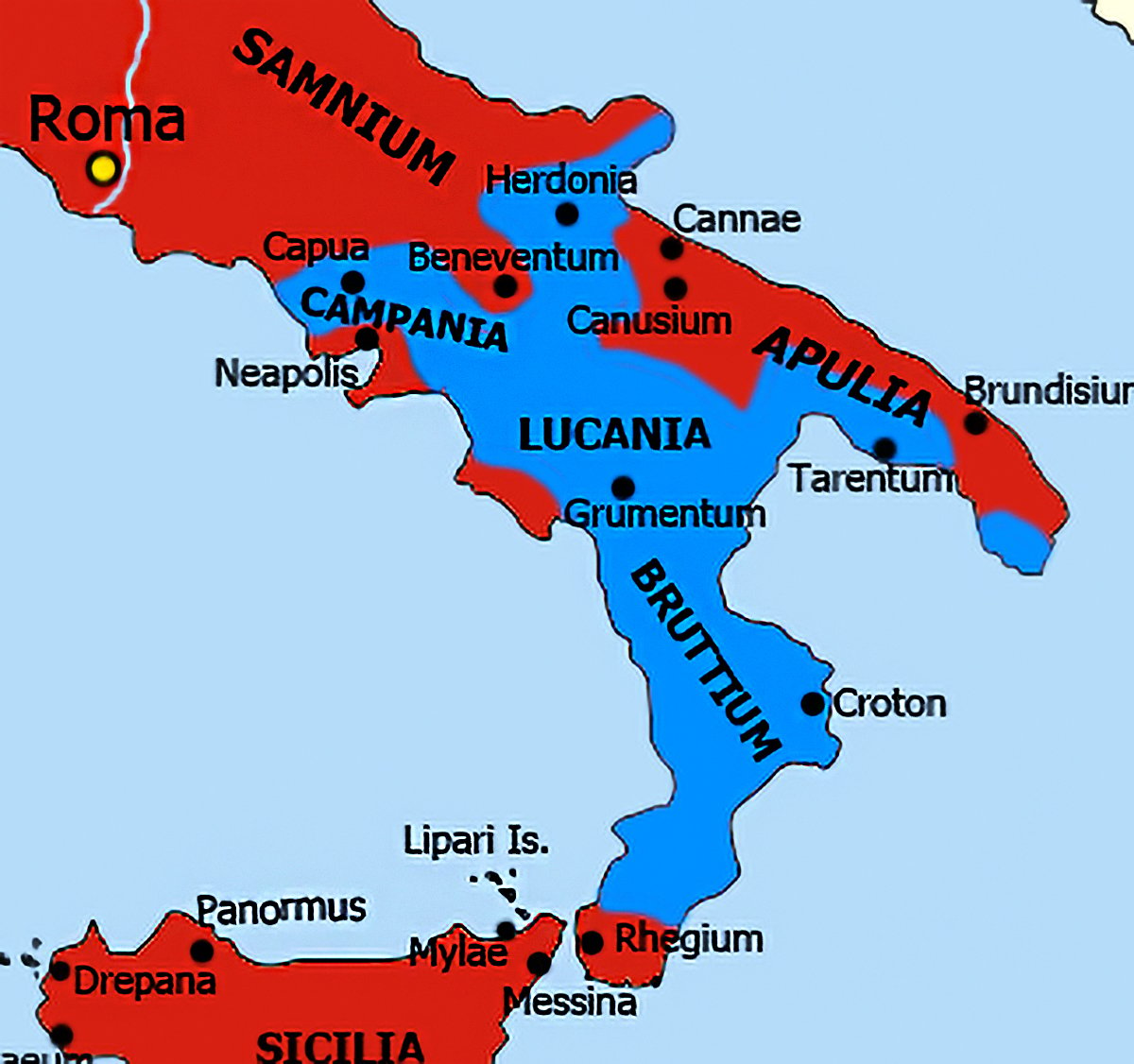
Cannae would also lead to the defection of several Roman allied cities, including Capua in Southern Italy, that would be allied with Hannibal from now on. These Carthaginian victories would also prove that Hannibal was one of the ancient world’s greatest military generals and strategists and immortalize him for the next 2 millennia.
One wonders how Carthage failed to win despite such enormous victories over Rome and that too on Italian soil. The answer to this question is not an easy one, as there were many reasons why Carthage ended up losing the Second Punic War despite having a great start with several major victories under their belt.
Roman leadership never lost heart despite suffering the worst defeats in their history, and they just went ahead raising new armies to replace the losses sustained in these defeats. They also kept a second front open in Iberia as at the start of the Second Punic War, a Roman army was sent to Iberia to initially prevent Hannibal from crossing the Alps, but later on, their main goal was to prevent Hannibal from getting significant reinforcements that he desperately needed.
The Carthaginian Senate and leadership, on the other hand, lacked the iron resolve displayed by their Roman counterparts, and some say that Hannibal’s worst enemies were not in Rome but in Carthage. A closer inspection of the facts would reveal this statement to be accurate, as Hanno, the leader of the Carthaginian senate, would do everything in his power to prevent the Senate from sending reinforcements to Hannibal.
Romans, during the course of the war, just tailed Hannibal and avoided any direct engagement with his forces. They were essentially fighting an ancient version of the war of attrition as their earlier defeats at the hand of Hannibal had taught them the painful lesson that they might not be able to defeat him easily.
During the course of the Second Punic War, Rome would siege and capture Syracuse, the only remaining part of Sicily that wasn’t under their direct control and would also do a great job in preventing the Carthaginian navy from gaining a foothold in the Mediterranean that would’ve made it easier for Carthage to reinforce and supply Hannibal.
While not being able to take on Hannibal on Italian Soil, Romans under the leadership of Publius Cornelius Scipio would achieve several major victories in Iberia, such as the Battle of Baecula in 208 BC, where a Roman army led by Publius Scipio would defeat a Carthaginian army led by Hasdrubal Barca, a brother of Hannibal.
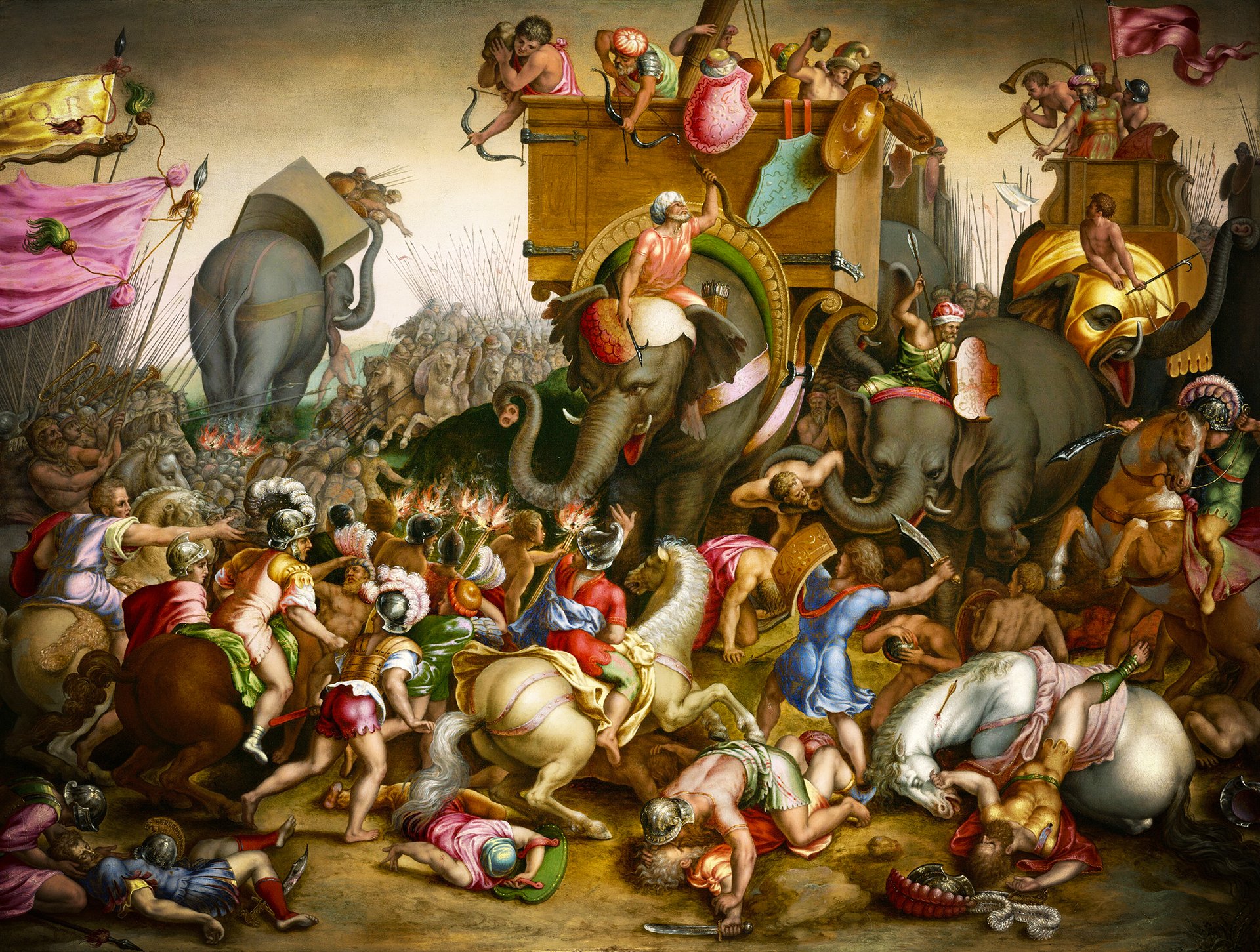
Romans would achieve an even more impressive victory at the Battle of Ilipa in 206 BC. In this battle, a Roman Army led by Scipio would defeat an army of similar size led by Mago Barca, another brother of Hannibal, and Hasdrubal Gisco, another Carthaginian general.
These Roman victories would seal the fate of Carthage on the Iberian Peninsula and end Carthaginian control on Iberian soil.
Romans prepared an invasion fleet in 205 BC that would land on the African continent in 204 BC with the goal of capturing Carthage. This African invasion would lead to the Battle of Zama, perhaps the only major lost by Hannibal in his career. The Carthaginian defeat would essentially seal the fate of Carthage, who would be forced to sign a humiliating treaty with Rome and would be forbidden from acquiring any territory in Europe or even Africa, for that matter.
Carthage was now subjected to a hefty war indemnity of 10,000 silver talents to be paid over 50 years. Carthage would be forbidden from having any navy, and they’d need prior permission from Rome before waging a war outside or within Africa.
The Second Punic War essentially destroyed the Carthaginian Empire as now the territory under Carthaginian control was limited to Carthage city and surrounding areas. Carthage wouldn’t be able to recover from this severe blow.
Compared to the first and second Punic Wars, the Third Punic War was relatively swift and would lead to the complete destruction of Carthage. Under the peace treaty signed between Rome and Carthage after the Second Punic War, Carthage now needed permission from Rome before fighting a war.
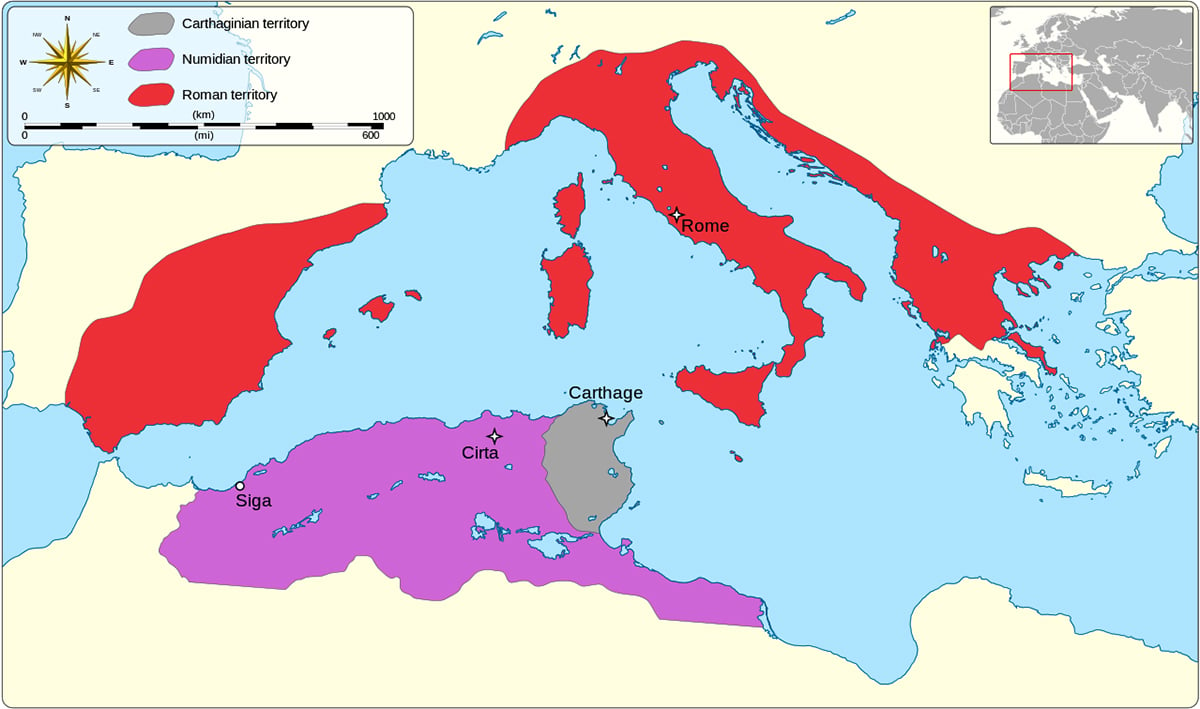
The Numidian kingdom, a neighbor of Carthage, was an ally of Rome, and they captured several Carthaginian territories, taking advantage of the weakness of Carthage in the ensuing years. Carthage appealed several times to Rome, asking for permission to defend their lands, but each time, Rome would deny them and would instead support their Numidian ally.
Carthage had paid the heavy indemnity forced on it by the terms of the peace treaty by 151 BC and was once again prospering economically, although it was in no way posing a threat to Rome. After decades of humiliation at the hands of Numidians, Carthaginians assembled an army of 30,000 men that would meet the Numidian army at the Battle of Oroscopa in 151 BC.
The Carthaginians would end up losing the battle with heavy losses. Still, Rome would use this breach of the treaty as a pretext for sending a punitive expedition to Carthage that would land on Carthaginian soil in 149 BC. There was a powerful lobby in Rome that wanted to destroy Carthage completely, and they were adamant not to stop until Carthage was wiped off from Earth’s face.
The Roman army would lay a siege to Carthage that would last for 3 years and would end up in total destruction of Carthage as a city and society. This destruction of Carthage would effectively open the door for Roman colonization of Africa and would change the course of history.
While the Roman Republic was an emerging power in the Mediterranean at the start of the Punic Wars, it was not a match for Carthage. With Carthage’s defeat and complete destruction during the Punic Wars, Rome emerged as the undisputed hegemon of the Western Mediterranean region. It can be argued that Rome became an empire only after winning the Punic Wars.
No one in their right mind would have imagined in the 3rd century BC that Rome would not only defeat its much stronger, better-armed foe in each of the 3 Punic Wars but would also end up destroying their rival gruesomely.
If we dwell in an alternate history, then it’s not difficult to see how Punic wars changed the world. If Rome had been defeated in the Punic Wars, it would probably have been wiped out like what happened to Carthage, and there wouldn’t have been any Roman empire to talk about.
Just imagine for a moment that Carthage emerged as a victor in the Punic Wars and used its newly found strength to capture Ptolemaic Egypt Levant, and it was Africans who were colonizing Europe. Christianity spread from the Middle East to Carthage, which adopted it as its official religion, and the Middle East and North Africa became the center of civilization. The possibilities are endless if we go down this route of imagination, but one thing is clear: our world would have been a different place if Rome had lost the Punic Wars.
